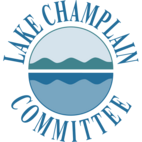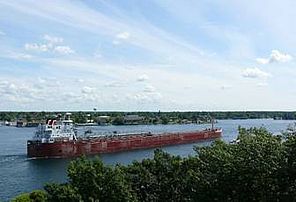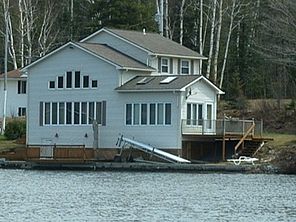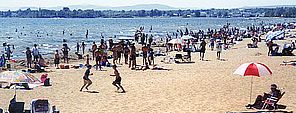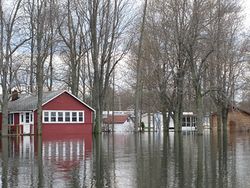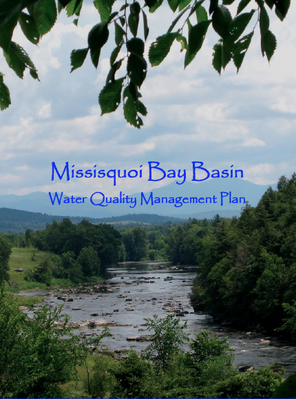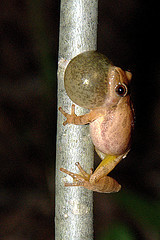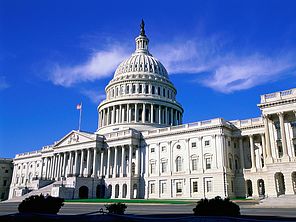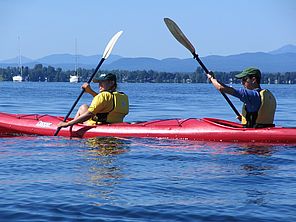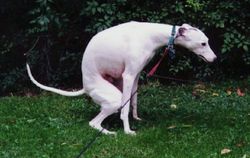LCC April Ripples E-News: What do the Beatles & LCC have in common and more
Dear LCC Members and Friends,
The sap is running, the birds are singing, and spring is in the air! Read on to learn about lake issues, recent work, upcoming happenings, and a reflection on our founding.
The Founding of LCC
Throughout the year, we will share a series of special feature articles in commemoration of the Lake Champlain Committee's 50-year anniversary. Here is the first one!
What do zip codes, the smiley face symbol, the Beatles, James Bond movies, push button phones, and the Lake Champlain Committee have in common? They all debuted in 1963. On May 17 of that year, a group of 93 concerned citizens met at the Middlebury Inn to organize in protest against a proposal to construct a shipping channel from the St. Lawrence River to the Hudson River utilizing Lake Champlain. This was the first official meeting of the Lake Champlain Committee. The stated purpose of the organization at the time was “to oppose the construction of the Champlain Waterway as being a project of little or no value to the economy of the states of New York or Vermont and especially of no value to the economy of the communities along Lake Champlain and an unjustifiable waste of taxpayers money and through this opposition to preserve the purity of the waters of Lake Champlain and to promote its greatest economical potential – recreation.”
The idea of a Seaway between Montreal and New York City had powerful support. An inland route would chop over 1,000 miles off the trip between the two ports. Developers dangled visions of thriving lakeside communities catering to the passing vessels. Less than a week after LCC’s organizational meeting the Vermont Senate agreed to spend $10,000 to finance a Champlain Waterway Commission. The Burlington Free Press reported, “This commission is clearly ‘loaded’ in favor of the waterway,” and that the Senate bill had pre-judged the waterway to be “of immense economic benefit to Vermont.”
Over the course of the next four years the Lake Champlain Committee would systematically tear apart assumptions of economic benefit and bring to light the tremendous ecological damage that could be expected from construction of a Seaway. LCC pointed out that the communities along the Hudson River had failed to benefit when that channel was deepened and the port city terminus of Albany had in fact lost population while comparable up-state cities without a port had grown. Read more on the founding of LCC.
Protecting Vermont’s Lake Shores
One of LCC’s top legislative priorities in Montpelier this year has been the passage of a lakeshore protection bill. Currently, any shoreline zoning is left to local communities but only 20% of towns have taken advantage of such opportunities, leaving many of the states waters vulnerable to wanton development. Such a bill was drafted in the House Committee on Fish Wildlife and Water Resources. The committee held a public hearing on the measure on March 12, and amended their proposal as a result. Finally, after 11 versions of the bill the committee voted 8-1 to support it. The final version was weaker in some ways than LCC would like, but represents an important step forward in lake protection. The bill went to the House floor on Wednesday March 27 where it faced some hostile amendments, but these were defeated and the bill passed 105-42. It now proceeds to the Senate.
Ginny Garrison, who served for more than 25 years as chief of Vermont's Lakes and Ponds Management and Protection Section at the VT Department of Environmental Conservation, offers her thoughts on why shoreline regulations are necessary to protect water quality:
"Requiring statewide regulations for land clearing and the creation of impervious surfaces along shorelands is the single most effective step the Vermont Legislature can take to protect Vermont’s lakes. A few years ago I retired after 35 years working on Vermont’s lakes as a biologist for the VTDEC’s Water Quality Division. I have seen first-hand the negative impact that clearing along shorelands and the creation of impervious areas such as roofs and driveways can have on Vermont’s lakes. Read more on Protecting Vermont's Lake Shores.
Cumberland Bay De-listed
On March 27 Cumberland Bay was officially removed from the list of New York’s toxic Superfund sites. De-listing represents the culmination of work undertaken over a decade ago, spearheaded by LCC. The original listing came about because of an accumulation of PCB-laden sludge in the bay. The sludge was directly deposited prior to the 1973 construction of the wastewater treatment facility in Plattsburgh. PCBs in the sludge had been used as an ink-carrier in copy paper produced by Vanity Fair Paper Company and later Georgia Pacific after the companies merged.
The PCB bed in Cumberland Bay was discovered following the first lake-wide toxic contaminant study, a project initiated following substantial advocacy by the Lake Champlain Committee (LCC). LCC then championed the clean-up strategy to remove the PCBs. The Environmental Protection Agency’s maximum allowed contaminant level for PCBs is 50 parts per million. By comparison, the Cumberland Bay sludge had PCB concentrations as high as 1,850 parts per million. Between April of 1999 and October of 2000, over 140,000 tons of contaminated paper sludge were dredged from a 57-acre area of the bay. Wastes had to be shipped to Buffalo for incineration while less hazardous material was landfilled in Quebec. Read more on Cumberland Bay.
A Response to Flooding
How much effort should society spend in preparing for rare events? The answer surely depends on the scope of the event, its rarity, and damage or costs associated with preparations. So, with these criteria in mind let’s examine potential responses to the Lake Champlain flooding of 2011.
The question is relevant because an international workgroup has recently released a plan of study for how to address the floods, and tentatively recommended $14 million worth of studies that might lead to a proposed solution. The workgroup was assembled by and reports to the International Joint Commission (IJC). The IJC helps implement a 1909 treaty between Canada and the United States designed to prevent and resolve disputes over water resources between the two countries. The IJC was asked by the governments of Canada and the United States to figure out what studies might be necessary to remediate flood damage on Lake Champlain. Learn more about the IJC's flood response in this issue of Lake Look.
Missisquoi Bay Basin Water Quality Management Plan Released
The Vermont Agency of Natural Resources has approved the Missisquoi Bay Basin water quality management plan. The Missisquoi watershed begins with mountain streams and gorges on the flanks of the Green Mountains and includes the pastoral meanderings of the Missisquoi River along the Canadian border. Lake Carmi, and other lakes, rivers, and wetlands comprise the network of waterbodies in the Basin. The lowest section includes the Missisquoi River delta - a complex of marshes, floodplain and wetland forests covering thousands of acres.
The management plan provides an overview of the health of the basin and a description of priority ongoing and future steps to restore and protect water quality. Sedimentation, turbidity, habitat alterations, nutrient loading, river corridor encroachment and metals from the Eden Mine were some of the stressors identified as negatively impacting water quality. The plan includes an implementation table, which identifies specific actions to address these and other problems. Examples include reducing bacteria in specific area brooks; evaluating the feasibility of removing the Swanton Dam to improve fish habitat; augmenting stormwater system mapping and addressing 13 suspected illicit discharges identified in the towns of Enosburg Falls, North Troy, Richford and Swanton; and reducing phosphorus from the most critical sources. Read more on the Missisquoi Bay Plan.
Nature Note: Amphibians in the night
On warm wet evenings from mid-March through April you can often find salamanders and woodland frogs creeping over the still cold ground. They travel from the woods where they hibernated to vernal pools and swamps where they will breed. In prime habitat multiple species of salamanders can be found: Jefferson, blue-spotted, yellow-spotted, red-backed, four-toed, and Eastern newt. Frog species consist principally of spring peepers and wood frogs, joined later by Eastern toads. The migrations can be observed along any roadsides separating woods and swamp.
Once at their breeding grounds, the frogs and toads begin calling for mates. Their songs come to define the onset of spring. Spring peepers probably have the best known call. Their clear high peeps have been heard practically year-round, but they are most active between mid-March and June after they migrate from their woodland hibernation hide-outs to vernal pools for mating. Researchers estimate that a single male repeats his call about 4,500 times on any given night. American toads offer another common song. Their high-pitched sweet trill comes from the shores of ponds, lakes, and rivers. Toads begin singing slightly later in the season than peepers. Read more about amphibians at night.
LCC Talks Water in Washington
Earlier this month, LCC Executive Director Lori Fisher teamed up on Capitol Hill with water advocates from across the country. In meetings with policy makers and legislative staff, she and water partners from Galveston Bay to Long Island Sound stressed the need for sustained national investment in our waterways. The gathering was part of the annual meeting the America's Great Waters Coalition. The Coalition was formed in 2009 and is an alliance of national, regional and state organizations working to protect and restore the waterways that are the lifeblood of our country and our economy. During the DC trip Lori also met with the offices of Senator Leahy, Senator Sanders, Congressman Welch and others to discuss a host of lake issues including funding, flood resiliency, infrastructure needs, and the Champlain Canal.
Wanted: Photos and Tales from the Trail
We're at work on the 2013 edition of the Trail guide and other Trail promotional materials. If you have pictures and stories from your 2012 water outings that you haven't shared yet, we'd love to see and hear them. Please email photos to LCC at lcc@lakechamplaincommittee.org with the date, location description, and name of the photographer and let us know if we're free to use them in print and online media. Thanks for your help!
Join In "April Stools Day"
LCC is doggedly searching for citizen involvement in an “April Stools Day” clean-up event in the Champlain watershed. On Monday, April 1 or any convenient time head outside with your gloves and plastic bags to clean up pet doo from parks, sidewalks, and recreation paths. While most pet owners conscientiously pick up after their dogs, pets with irresponsible owners leave reminders all around for the rest of us to deal with.
“Pet poop contains bacteria and excess nutrients that are bad for our health and waterways,” said Lori Fisher, LCC Executive Director. “Dog doo left on hard surfaces washes into stormdrains any time the snow melts or it rains. From there it enters streams or Lake Champlain from which almost 200,000 people get their drinking water.” The majority of water that goes through stormdrains doesn’t get treated.
LCC advises participants to wear old clothes and gloves and bring a plastic bag and trowel for picking up pet deposits. Pet poop remains should be flushed down the toilet or deposited in the garbage along with any other trash you find during your outings. Read more scoop on poop.
April 3 - Spa Night for Water Quality
Does your back ache? Are your nails unruly? Could you use some TLC? Or do you just want to support a good cause? Head on down to O'Briens Aveda Institute at 1475 Shelburne Road in South Burlington on April 3 between 3:00 and 7:00 PM for some pampering. A $20 donation at the door gets you three spa services. Manicures, pedicures, facial waxing, make-up, facials, paraffin wax, and massage will all be offered by O'Brien's students and staff who are donating their time and talents to raise money for LCC! First come, first served. Funds raised will support LCC's work to protect and restore water quality, safeguard natural habitats, promote access, and foster stewardship.
April 22 - Earth Day Cut-a-thon for Clean Water
Area Aveda salons will be co-hosting a cut-a-thon on Earth Day at O'Brien's Aveda Institute in South Burlington. The event is part of a global round the clock cut-a-thon to raise money and awareness for water protection and set a Guinness World Record for the most money raised for charity by haircuts in a 24-hour period.
Aveda stylists in salons worldwide - from Tokyo, to Sydney, Moscow, London, New York, and South Burlington -- will volunteer their time to offer haircuts in return for a donation to Earth Month water protection efforts. Continue to check LCC's Calendar of Events and Facebook page closer to the date for further details.
Moving? Changing Email Addresses?
If you’ve changed your address recently, please send us an email so we can update your files and ensure you receive news on lake issues and LCC’s work. Email is our primary form of communication with members. Mailing electronically saves time and resources and reinforces the stewardship ethic of our mission. We don’t give away or sell email addresses.
To ensure you receive email from LCC, please add lcc@lakechamplaincommittee.org and the domain enews.lakechamplaincommittee.org to your safe/allowed list and address book. Thanks!
Like LCC on Facebook!
Follow LCC on Facebook for beautiful lake photos, informative updates, lake conversations and more!
Lake Champlain Committee Board of Directors
Gary Kjelleren - Chair (South Hero, VT), Sharon Murray - Treasurer (Bolton, VT), Alan Booth (Plattsburgh, NY), Sandy Montgomery (Montreal, QC), Ann Ruzow Holland (Willsboro, NY), Mary Van Vleck (Charlotte, VT), Chuck Woessner (Grand Isle, VT).
Lake Champlain Advisory Council
Megan Epler Wood (Burlington, VT), Steven Kellogg (Essex, NY), Peter S. Paine, Jr. (Willsboro, NY), Mary Watzin (NC).
Lake Champlain Committee Staff
Lori Fisher, Executive Director
Jessica Rossi, Office Manager
Mike Winslow, Staff Scientist
